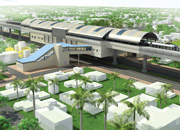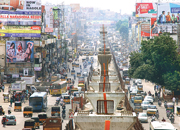Acceptance to B&R Facilities
Around 7.4% of the bicycle owners have shown interest for the B&R services, of which only 5.2% of the total sample have their trips within the BRT egress coverage area. The average household income of these people is around `11000 per month.
People with travel distance on BRT of more than 4km prefer B&R services. For the users willing to use B&R, their average travel distance on BRT is around 7.5km. As access distance increases, the level of acceptance decreases. People are more willing to use B&R services upto a distance of 1.25km from the stations.
Economic Travel Characteristics
A comparison of travel cost and travel time by a two wheeler and B&R service was undertaken. It was seen that for a travel distance of more than 4km it is economical to shift for B&R services. A minimum travel distance of 4km through B&R services will lose up to 4 min. It is calculated based on average speeds of different modes.
Potential Locations for “B&R” System
A total 5.2% of willingness trips are expanded to the whole population in the zones and seven same type and same characteristics of stations are identified in Ahmedabad. The same percentage of willingness is assumed at all stations to identify the maximum potential shift of commuters from private vehicles to B&R services.
Economic Analysis
The economic analysis is carried out for a period of 20 years for the development of the “B&R” system at the Sola Crossroad BRT station, Ahmedabad. It is estimated that the Economical Internal Rate of Return (EIRR) of the project will be around 20.1%, and can be considered for implementation from the economic perspective.
The potential shift of commuters seems high at the interchange stations. The same criteria may be considered while locating the B&R facility. Provision of public bicycles and/or rentals can further add in attracting users. However, it should be noted that change in mode share due to such initiative is likely to be small. To ensure shift to more sustainable modes, other alternative measures like public transport improvements, demand management and pricing measures.
 TrafficInfraTech Magazine Linking People Places & Progress
TrafficInfraTech Magazine Linking People Places & Progress


